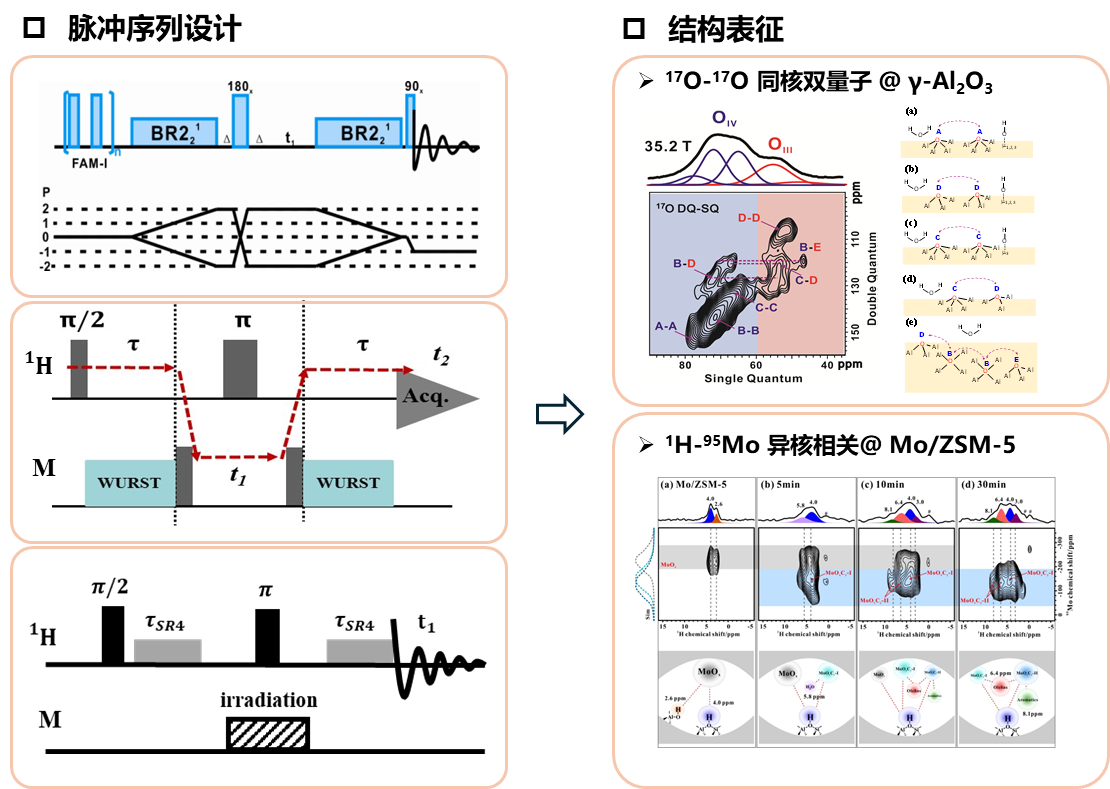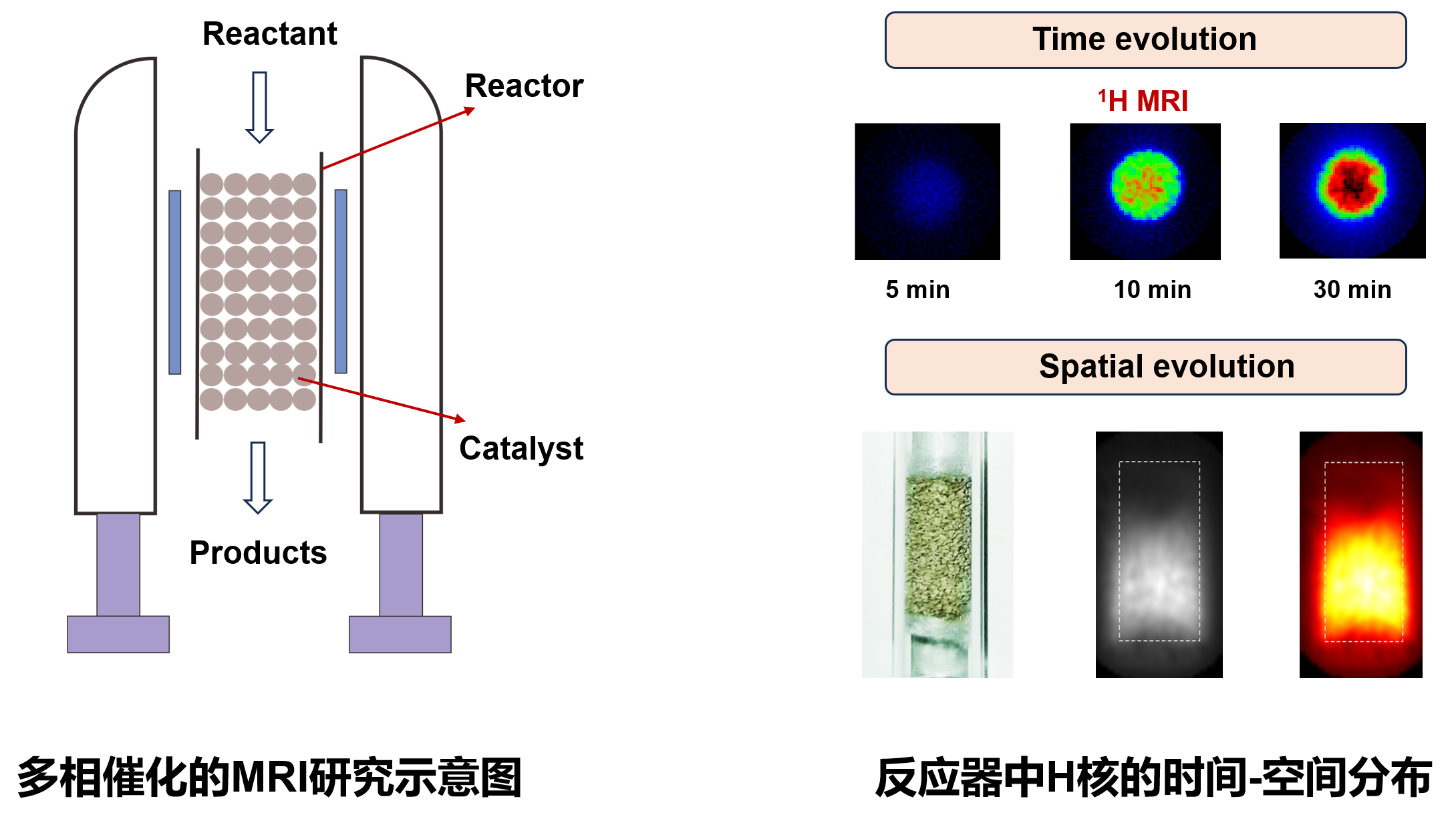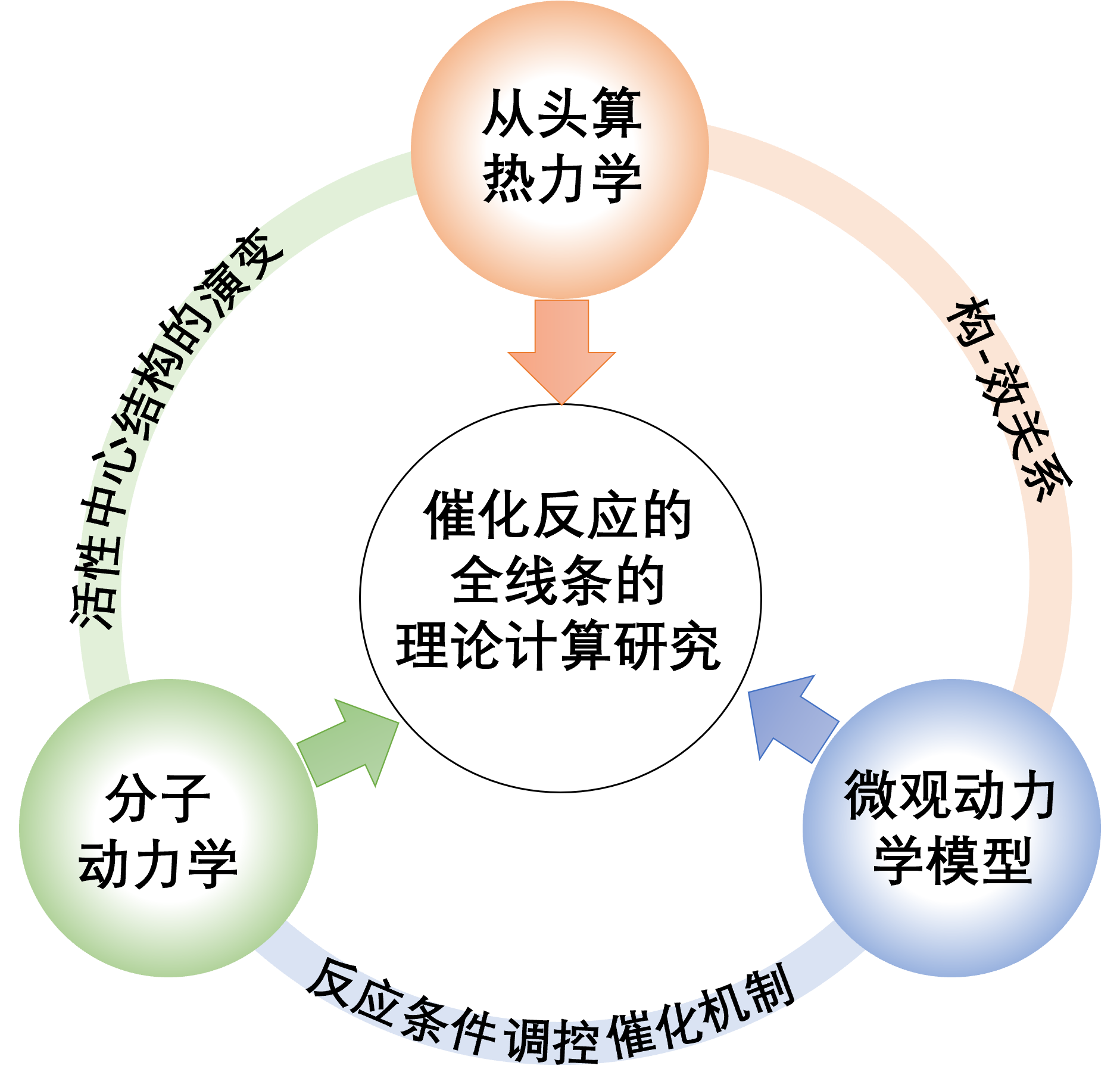The efficient use of energy and resources is a critical challenge for achieving global sustainability. Our research focuses on heterogeneous catalytic reaction systems involving low-carbon molecules, specifically investigating catalyst structure and reaction mechanisms within the realm of surface and interface chemistry. We aim to develop advanced solid-state nuclear magnetic resonance (ssNMR) spectroscopic techniques, complemented by theoretical calculations, for application in the field of heterogeneous catalysis. Our goal is to elucidate the microstructures of catalysts (active sites) and catalytic reaction mechanisms at the atomic-molecular level. By establishing structure-activity relationships for catalysts, we aim to guide the development of high-performance catalysts and provide sophisticated spectroscopic methods for studying complex catalytic materials and reactions.
In Situ and Operando NMR Technique and Catalytic Reaction Mechanism
The focus is on the development of in situ and operando ssNMR technique enables NMR characterization of gas-solid and liquid-solid catalytic reaction processes within a wide range of temperatures (up to 400°C) and pressures (up to 50 bar). This technique allows for the direct observation and analysis of the dynamic changes in the structure and molecular dynamics of catalysts during the reaction process. Integrating rapid sampling methods further enhances the ability to quickly track and analyze these changes, providing a deeper understanding of the catalytic reaction mechanism.

1. Wang, X. M.; Qi, G. D.; Xu, J.; Li, B. J.; Wang, C.; Deng, F. NMR-Spectroscopic Evidence of Intermediate-Dependent Pathways for Acetic Acid Formation from Methane and Carbon Monoxide over a ZnZSM-5 Zeolite Catalyst. Angew. Chem. Int. Edit. 2012, 51, 3850-3853.
2. Zhou, X.; Wang, C.; Chu, Y.; Xu, J.; Wang, Q.; Qi, G.; Zhao, X.; Feng, N.; Deng, F. Observation of an oxonium ion intermediate in ethanol dehydration to ethene on zeolite. Nat. Commun. 2019, 10, 1961.
3. Wang, C.; Zhao, X.; Hu, M.; Qi, G.; Wang, Q.; Li, S.; Xu, J.; Deng, F. Unraveling Hydrocarbon Pool Boosted Propane Aromatization on Gallium/ZSM-5 Zeolite by Solid-State Nuclear Magnetic Resonance Spectroscopy. Angew. Chem. Int. Edit. 2021, 60, 23630-23634
Development and Application of ssNMR Technique
To tackle the persistent challenges of sensitivity and resolution in ssNMR observations, the focus is on designing multi-dimensional, multi-nuclear SSNMR experimental pulse methods under high magnetic fields and high-speed magic angle spinning. This approach aims to significantly enhance the observation efficiency of vital nuclides (such as quadrupolar nuclei 27Al, 67Zn, 95Mo, 17O) in heterogeneous catalytic materials. These advancements enable to gain more detailed insights into the structure and dynamics of these materials, ultimately contributing to the development of more efficient and sustainable catalytic processes.

1. W. Gao; Q. Wang; G. Qi; J. Liang; C. Wang; J. Xu; F. Deng, Active Ensembles in Methane Dehydroaromatization over Molybdenum/ZSM-5 Zeolite Identified by 2D 1H−95Mo Magic Angle Spinning Nuclear Magnetic Resonance Correlation Spectroscopy. Angew. Chem. Int. Ed. 2023, 62, e202306133.
2. M. Zheng; S. Zeng; X. Wang; X. Gao; Q. Wang; J. Xu; F. Deng, Heteronuclear-filtered 1H homonuclear multi-quantum correlation experiment at 100 kHz magic-angle spinning. Magnetic Resonance Letters 2022, 2, 266-275.
3. Q. Wang; W. Li; I. Hung; F. Mentink-Vigier; X. Wang; G. Qi; X. Wang; Z. Gan; J. Xu; F. Deng, Mapping the oxygen structure of γ-Al2O3 by high-field solid-state NMR spectroscopy. Nat. Commun. 2020, 11, 3620.
Hyperpolarization NMR Technique and Applications
To address the inherent low sensitivity of NMR, the focus is on the development of parahydrogen-induced polarization (PHIP) and dynamic nuclear polarization (DNP) techniques. These techniques disrupt the Boltzmann distribution of spin nuclei at thermal equilibrium, resulting in several orders of magnitude enhancement in NMR signal intensity. This significant improvement facilitates highly sensitive structural characterization of catalytic materials. When combined with in situ NMR technology, these hyperpolarized methods enhance the signals of low-concentration reaction species, such as intermediates and products, enabling polarized observation of catalytic reactions under actual operating conditions. This integration allows for deeper insights into reaction mechanisms and catalyst performance in real-time.

1. W. Wang; R. J. Lewis; B. Lu; Q. Wang; G. J. Hutchings; J. Xu; F. Deng, The Role of Adsorbed Species in 1-Butene Isomerization: Parahydrogen-Induced Polarization NMR of Pd–Au Catalyzed Butadiene Hydrogenation. ACS Catal. 2024, 14, 2522-2531.
2. W. Wang; Q. Wang; J. Xu; F. Deng, Understanding Heterogeneous Catalytic Hydrogenation by Parahydrogen-Induced Polarization NMR Spectroscopy. ACS Catal. 2023, 13, 3501-3519.
3. W. Y. Wang; Q. M. Sun; Q. Wang; S. H. Li; J. Xu; F. Deng, Heterogeneous parahydrogen induced polarization on Rh-containing silicalite-1 zeolites: effect of the catalyst structure on signal enhancement. Catal. Sci. Technol. 2022, 12, 4442-4449.
Magnetic Resonance Imaging in Catalytic Reaction Systems
Magnetic resonance imaging (MRI) is employed to characterize heterogeneous catalytic systems, ranging from catalyst particles to pilot reactors. By integrating MRI with SSNMR, the goal is to capture and analyze the temporal and spatial distribution of heat, mass, and diffusion processes during heterogeneous catalytic reactions. This approach provides valuable experimental data that can inform the design of high-performance catalysts and the optimization of reaction processes.

1. Wang, C.; Zheng, M.; Hu, M.; Cai, W.; Chu, Y.; Wang, Q.; Xu, J.; Deng, F., Unraveling Spatially Dependent Hydrophilicity and Reactivity of Confined Carbocation Intermediates during Methanol Conversion over ZSM-5 Zeolite. J. Am. Chem. Soc. 2024, 146, 8688-8696.
2. Wang, C.; Chu, Y.; Xiong, D.; Wang, H.; Hu, M.; Wang, Q.; Xu, J.; Deng, F., Water-Induced Micro-Hydrophobic Effect Regulates Benzene Methylation in Zeolite. Angew. Chem. Int. Edit. 2024, 63 , e202313974.
3. Xu, R.; Wang, Q.; Wang,W.; Bao, Q.; Zhang, Z.; Liu, C.; Xu, J.; Deng, F., In situ NMR Imaging of Solvent Infiltration on γ-Al2O3 particles. Chem. J. Chinese Universities., 2023, 44, 20220587.
Photocatalytic Reaction Mechanisms
Solid-state NMR and EPR techniques are utilized to investigate the microscopic structure of catalysts, revealing catalytic active sites and establishing structure-activity relationships. By integrating in-house developed in situ and operando methods, the aim is to achieve real-time monitoring of photocatalytic reactions. This capability enables the capture of reaction intermediates, facilitating the elucidation of the mechanisms that govern photocatalytic processes.

1. Feng, N. D.; Wang, Q.; Zheng, A. M.; Zhang, Z. F.; Fan, J.; Liu, S. B.; Amoureux, J. P.; Deng, F., Understanding the High Photocatalytic Activity of (B, Ag)-Codoped TiO2 under Solar-Light Irradiation with XPS, Solid-State NMR, and DFT Calculations, J. Am. Chem. Soc. 2013, 135, 1607-1616.
2. Liu, F.; Feng, N. D.; Wang, Q.; Xu, J.; Qi, G.; Wang, C.; Deng, F., Transfer Channel of Photoinduced Holes on a TiO2 Surface As Revealed by Solid-State Nuclear Magnetic Resonance and Electron Spin Resonance Spectroscopy. J. Am. Chem. Soc. 2017, 139, 10020-10028.
3. Feng, N. D.; Lin, H.; Song, H.; Yang, L.; Tang, D.; Deng, F.; Ye, J., Efficient and selective photocatalytic CH4 conversion to CH3OH with O2 by controlling overoxidation on TiO2. Nature Commun. 2021, 12, 4652.
Theoretical Chemical Calculations in Catalytic Reactions
Integrating ab initio thermodynamics, molecular dynamics, and microkinetic modeling approaches, the focus is on elucidating the specific structures and evolution processes of catalyst active centers under operating conditions. This multifaceted approach enables the examination of the mechanisms governing the adsorption, diffusion, and transformation of reactants on catalysts. The goal is to establish a clear relationship between the microstructure of catalysts and the underlying catalytic reaction mechanisms at the atomic-molecular level. By doing so, a comprehensive theoretical framework can be developed to study and understand complex catalytic processes more thoroughly.


1. Y. Chu; X. Yi; C. Li; X. Sun; A. Zheng, Brønsted/Lewis acid sites synergistically promote the initial C–C bond formation in the MTO reaction. Chem. Sci. 2018, 9, 6470-6479.
2. Y. Chu; A.-Y. Lo; C. Wang; F. Deng, Origin of High Selectivity of Dimethyl Ether Carbonylation in the 8-Membered Ring Channel of Mordenite Zeolite. J. Phys. Chem. C 2019, 123, 15503-15512.
3. Y. Chu; G. Li; L. Huang; X. Yi; H. Xia; A. Zheng; F. Deng, External or internal surface of H-ZSM-5 zeolite, which is more effective for the Beckmann rearrangement reaction? Catal. Sci. Technol. 2017, 7, 2512-2523.



